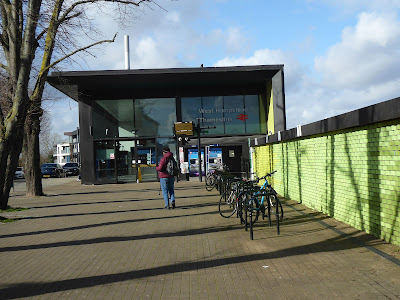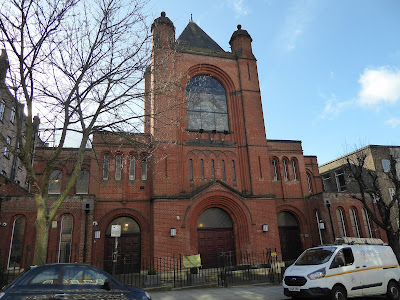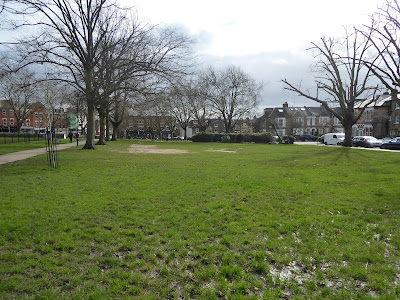Finchley Road station is the 17th station that I've visited on the Jubilee line. It is less than a 10 minute walk from the previous station, Swiss Cottage. The first station was opened in June 1879 by the Metropolitan Railway ( now the Metropolitan tube line). When the Metropolitan line became congested in the 1930s new tunnels were dug and opened to allow Bakerloo line trains to use the station. In 1979 the Bakerloo line through Finchley Road was transferred to the new Jubilee line.
The station services both the Jubilee and the Metropolitan lines. It has four platforms which are at ground level.


The present station was built in 1914 with entrances incorporated into a parade of shops on the corner of Finchley Road and Canfield Gardens.
 The first building to catch my eye on Finchley Road is the Waitrose John Barnes building. There was no information outside the building but it was easy to research on the internet. It was built as a department store in 1900 and financed by a group of well established retailers including John Barnes, the chairman of the group. Sadly John Barnes died before the store was opened. He tragically drowned in 1899, during a storm, whilst travelling on a steam ship off the coast of the Channel Islands. Perhaps that is why the store was named in his honour. The store consisted of two selling floors with accommodation for 400 members of staff on the third and fourth floors. One floor for women and one for men. The accommodation also included a library, dining rooms and sitting rooms. It was not unusual in the late 19th and early 20th century for department stores to provide accommodation for staff. Bourne and Hollingsworth, which was founded in 1894, provided accommodation for 600 female members of staff.
The first building to catch my eye on Finchley Road is the Waitrose John Barnes building. There was no information outside the building but it was easy to research on the internet. It was built as a department store in 1900 and financed by a group of well established retailers including John Barnes, the chairman of the group. Sadly John Barnes died before the store was opened. He tragically drowned in 1899, during a storm, whilst travelling on a steam ship off the coast of the Channel Islands. Perhaps that is why the store was named in his honour. The store consisted of two selling floors with accommodation for 400 members of staff on the third and fourth floors. One floor for women and one for men. The accommodation also included a library, dining rooms and sitting rooms. It was not unusual in the late 19th and early 20th century for department stores to provide accommodation for staff. Bourne and Hollingsworth, which was founded in 1894, provided accommodation for 600 female members of staff. In 1926, the store was taken over by Gordon Selfridge and completely rebuilt in 1935. The staff no longer lived above the shop and three floors were now used for retail. Five floors of flats were built above the store. The John Lewis partnership acquired the store in 1940 and it continued to thrive until the opening of a large shopping mall at Brent Cross in 1976 had a detrimental effect on the store. However its food hall continued to be popular and in 1981 the decision was made to turn the store into one of the largest Waitrose branches in the country. Waitrose (part of the John Lewis partnership) is a food store.
In 1926, the store was taken over by Gordon Selfridge and completely rebuilt in 1935. The staff no longer lived above the shop and three floors were now used for retail. Five floors of flats were built above the store. The John Lewis partnership acquired the store in 1940 and it continued to thrive until the opening of a large shopping mall at Brent Cross in 1976 had a detrimental effect on the store. However its food hall continued to be popular and in 1981 the decision was made to turn the store into one of the largest Waitrose branches in the country. Waitrose (part of the John Lewis partnership) is a food store.

Across the road from the John Barnes building is the Holy Trinity church. If it wasn't for the cross I doubt I would have realised it was a church. It looks very small from where I was standing. I discovered that the original church was built here in 1871. It was an expensive church to build as it needed specially deepened concrete foundations beneath the steeple to guard against vibrations from the trains travelling beneath on the Metropolitan line. The redevelopment of the site was approved in 1968. The church was demolished in 1974 and this smaller one built.

I walked back along the the Finchley Road towards Swiss Cottage to have a look at a large pub, the North Star. This was one of the first buildings to be built on Finchley Road in 1850. The road was constructed in 1835 as an alternative route from London to the north of England rather than travelling through the narrow congested streets of Hampstead. The North Star was purpose built as a pub. At one time in the 1920s the pub was used as the terminus for short haul trams out of London. In the 1930s when the Bakerloo Line was extended, the Metropolitan line had to be diverted and the tunnel carrying the southbound line is just three feet below the pub's cellar.
I left the Finchley Road and turned left up College Crescent and there on the corner with Fitzjohn's Avenue is this unusual drinking fountain with its protective canopy.
The stepped base takes you inside the oak screened walls to the four bowled water fountain which is made from pink granite and stands below a vaulted roof.
You can still see the remains of the original water jets.
Above the bowls is a plaque with unusual ornamental writing with the inscription:
This fountain together with the open space on which it is erected, was presented to the Borough of Hampstead for the public benefit, in memory of the late Samuel Palmer of Northcourt, Hampstead by his widow and family, 1904.
Samuel Palmer was the last survivor of the three brothers who founded the biscuit making firm of Huntley and Palmer.

On the other side of Fitzjohn's Avenue is this sculpture of Sigmund Freud who lived in the area.
A short walk from the sculpture in Maresfield Gardens is Freud's Museum. When the Nazis annexed Austria in 1938, Freud left Vienna for London with his wife and daughter. Anna. He brought with him all his furniture, books and art collection. He had been diagnosed with cancer of the jaw in 1923 and died from cancer in 1939 at the age of 83. This was his home for the last year of his life. His daughter Anna, also a psychoanalyst lived here until she died in 1982. Anna Freud (1895-1982) was a pioneer in child analysis and the study of child development. She initially trained as a primary school teacher and later as a psychoanalyst. She lived and worked in this house for over forty years. It was Anna's wish that the house should become a museum dedicated to the life and work of her father. The house opened as the Freud Museum London in 1986.
As the museum was open I decided to have a look inside. I was glad I did as it was fascinating and needs a post all to itself.
This is the famous couch that he used.

The garden gave particular pleasure to Sigmund and his wife Martha. Back in Vienna their home only had access to a courtyard. A couch was set up for Sigmund so he could lie out here and enjoy the garden. He was lying out here on 3rd September 1939 when war with Germany was declared. He died later that month. His daughter Anna was very fond of the garden and continued to care for it. The garden today is as close to the original layout and planting as possible.

I followed the road round and it brought me back out on to the Finchley Road. A little further on was the large o2 shopping complex.
It looked a pleasant place to shop but once inside, it looked empty with many shops closed. Although it looks like a newish development, the owners want to redeveloped the whole site. The new plans include housing, a new park, supermarket. gym, cinema, community centre and health centre. The developers are waiting for the council to approve the plans.
The next place of interest I saw was the Camden Arts Centre. Not only was it open today but it also had free admission so went in to have a look at the exhibits. The gallery space consisted of three large, airy rooms displaying the work of two artists. It is the first time that either of the artists have had a solo exhibition in London. Here is a small example of their work.
Julien Creuzet from France creates work that incorporates music, video, poetry and sculpture.
These two pieces are by Allison Katz from Canada
Apart from the three galleries there was a reading room, an artist's studio and a drawing room. The drawing was full of materials for young children to enjoy and express their artistic talents.
Downstairs was a lovely cafe overlooking the garden, so I took the opportunity of a sit down with a cup of tea and a bite to eat.
I had a goat's cheese and caramelised onion tart and salad which was delicious.
Directly opposite the art centre on the Finchley Road is the Jewish Community centre. The centre is a cross communal hub for Jewish arts, culture, learning and more. I took this photo from the art gallery's window. I didn't want to upset anyone or create a security alert by being too close to take photos. Walking around the area just away from the Finchley road I was aware of the amount of security surrounding some of the houses such as high fences, CCTV, and even security guards. Best not to be trigger happy with the camera in what appears to be a sensitive area.
A little further down the road from the Jewish centre are some mansion blocks. This one, Dunrobin Court was built in 1928 and judging by the number of windows I imagine the apartments have large rooms filled with light. I saw a first floor 3 bed roomed apartment advertised for sale for £1.74m!
There are so many large houses or villas as they are called in this area They were built mid to late 19th century to attract the wealthy middle classes and their servants to live in the suburbs.

This property with its lion guarding the entrance is on Compagne Gardens. I hope this brings back memories of your family connection Diane.
 At the corner of Broadhurst Gardens and West End lane is The Railway pub. It used to have an upstairs function room known as the Klooks Kleek which hosted acts like the Rolling Stones, and Jimi Hendrix and Cream.
At the corner of Broadhurst Gardens and West End lane is The Railway pub. It used to have an upstairs function room known as the Klooks Kleek which hosted acts like the Rolling Stones, and Jimi Hendrix and Cream. 
































































